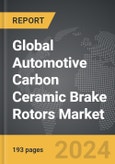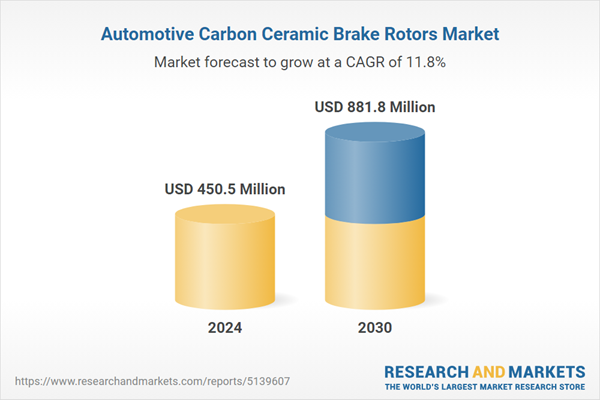The global market for Automotive Carbon Ceramic Brake Rotors was valued at US$450.5 Million in 2024 and is projected to reach US$881.8 Million by 2030, growing at a CAGR of 11.8% from 2024 to 2030. This comprehensive report provides an in-depth analysis of market trends, drivers, and forecasts, helping you make informed business decisions. The report includes the most recent global tariff developments and how they impact the Automotive Carbon Ceramic Brake Rotors market.
Segments: Rotor Type (Drilled Rotors, Slotted Rotors).
Geographic Regions/Countries: World; United States; Canada; Japan; China; Europe (France; Germany; Italy; United Kingdom; Spain; Russia; and Rest of Europe); Asia-Pacific (Australia; India; South Korea; and Rest of Asia-Pacific); Latin America (Argentina; Brazil; Mexico; and Rest of Latin America); Middle East (Iran; Israel; Saudi Arabia; United Arab Emirates; and Rest of Middle East); and Africa.
The analysts continuously track trade developments worldwide, drawing insights from leading global economists and over 200 industry and policy institutions, including think tanks, trade organizations, and national economic advisory bodies. This intelligence is integrated into forecasting models to provide timely, data-driven analysis of emerging risks and opportunities.
Global Automotive Carbon Ceramic Brake Rotors Market - Key Trends and Drivers Summarized
What Makes Carbon Ceramic Brake Rotors a Revolutionary Choice in High-Performance Vehicles?
Carbon ceramic brake rotors have become a pivotal innovation in the automotive industry, particularly for high-performance vehicles. These rotors are crafted from a blend of carbon fibers and ceramic materials, which provides them with a unique set of properties that distinguish them from traditional cast iron rotors. The primary advantage lies in their exceptional heat resistance, which allows them to operate efficiently at high temperatures without losing braking performance. This is crucial for vehicles that frequently undergo heavy braking, such as sports cars and luxury vehicles, where performance and safety are paramount. Unlike traditional rotors, carbon ceramic variants are much lighter, which reduces unsprung weight, improving the vehicle's overall handling and acceleration. Moreover, their resistance to corrosion and wear significantly extends their lifespan, making them a cost-effective choice over time, despite their higher initial cost. As a result, they are increasingly becoming the go-to option for automakers aiming to enhance the performance and safety of their vehicles.How Does the Manufacturing Process Influence the Performance of Carbon Ceramic Brake Rotors?
The manufacturing process of carbon ceramic brake rotors is a sophisticated and highly controlled operation that significantly impacts their performance characteristics. The process begins with the molding of carbon fibers into a preform, which is then infiltrated with silicon to create a carbon-silicon carbide matrix. This matrix is crucial because it endows the rotor with its high-temperature stability and low thermal expansion properties, ensuring consistent performance even under extreme conditions. After the matrix is formed, the rotors undergo a series of heat treatments to enhance their strength and durability. These treatments also improve their thermal conductivity, allowing for more efficient heat dissipation during braking. The final stage involves precision machining to achieve the desired shape and surface finish, which ensures optimal contact with the brake pads. The meticulous nature of this process means that carbon ceramic rotors are not only superior in performance but also highly reliable, with minimal variation in quality between batches. This consistency is vital for applications where precision and reliability are critical, such as in motorsports and high-end luxury cars.Why Are Carbon Ceramic Brake Rotors Preferred in High-End and Electric Vehicles?
Carbon ceramic brake rotors have found a strong foothold in high-end luxury and electric vehicles, and their popularity in these segments is not by chance. For luxury vehicles, where every component is expected to deliver the highest level of performance, carbon ceramic rotors provide unmatched braking efficiency and smoothness. Their ability to maintain performance across a wide temperature range ensures that these vehicles can stop quickly and safely, regardless of driving conditions. Additionally, the low weight of these rotors contributes to the overall reduction in vehicle mass, which is a critical factor for electric vehicles (EVs). In EVs, reducing weight is directly correlated with increased range and efficiency, making carbon ceramic rotors an attractive choice. Furthermore, the regenerative braking systems in EVs benefit from the superior wear resistance of carbon ceramic rotors, as these systems rely on a combination of traditional friction braking and electric motor resistance. The durability of carbon ceramic rotors means that they can withstand the unique demands of regenerative braking without significant degradation, ensuring long-term reliability and cost savings for EV owners.What Are the Key Drivers Fueling the Growth of the Carbon Ceramic Brake Rotor Market?
The growth in the carbon ceramic brake rotor market is driven by several factors that reflect broader trends in the automotive industry. First and foremost, the increasing demand for high-performance vehicles, including sports cars, luxury sedans, and SUVs, has led to a surge in the adoption of advanced braking systems. Consumers in this segment prioritize safety, performance, and longevity, all of which are provided by carbon ceramic brake rotors. Additionally, the rise of electric vehicles has also been a significant driver. As automakers strive to enhance the range and efficiency of EVs, the lightweight and durable nature of carbon ceramic rotors becomes increasingly attractive. Another critical factor is the growing focus on reducing vehicle emissions and improving fuel efficiency. By decreasing the overall weight of vehicles, carbon ceramic rotors contribute to these goals, making them a key component in the development of eco-friendly automotive solutions. Finally, advancements in manufacturing technologies have made the production of carbon ceramic rotors more cost-effective, allowing for wider adoption across various vehicle segments. As these trends continue to evolve, the demand for carbon ceramic brake rotors is expected to grow, solidifying their position as a staple in the future of automotive design and engineering.Report Scope
The report analyzes the Automotive Carbon Ceramic Brake Rotors market, presented in terms of units. The analysis covers the key segments and geographic regions outlined below.Segments: Rotor Type (Drilled Rotors, Slotted Rotors).
Geographic Regions/Countries: World; United States; Canada; Japan; China; Europe (France; Germany; Italy; United Kingdom; Spain; Russia; and Rest of Europe); Asia-Pacific (Australia; India; South Korea; and Rest of Asia-Pacific); Latin America (Argentina; Brazil; Mexico; and Rest of Latin America); Middle East (Iran; Israel; Saudi Arabia; United Arab Emirates; and Rest of Middle East); and Africa.
Key Insights:
- Market Growth: Understand the significant growth trajectory of the Drilled Rotors segment, which is expected to reach US$671.8 Million by 2030 with a CAGR of a 12.9%. The Slotted Rotors segment is also set to grow at 8.8% CAGR over the analysis period.
- Regional Analysis: Gain insights into the U.S. market, valued at $114.8 Million in 2024, and China, forecasted to grow at an impressive 15.5% CAGR to reach $212.4 Million by 2030. Discover growth trends in other key regions, including Japan, Canada, Germany, and the Asia-Pacific.
Why You Should Buy This Report:
- Detailed Market Analysis: Access a thorough analysis of the Global Automotive Carbon Ceramic Brake Rotors Market, covering all major geographic regions and market segments.
- Competitive Insights: Get an overview of the competitive landscape, including the market presence of major players across different geographies.
- Future Trends and Drivers: Understand the key trends and drivers shaping the future of the Global Automotive Carbon Ceramic Brake Rotors Market.
- Actionable Insights: Benefit from actionable insights that can help you identify new revenue opportunities and make strategic business decisions.
Key Questions Answered:
- How is the Global Automotive Carbon Ceramic Brake Rotors Market expected to evolve by 2030?
- What are the main drivers and restraints affecting the market?
- Which market segments will grow the most over the forecast period?
- How will market shares for different regions and segments change by 2030?
- Who are the leading players in the market, and what are their prospects?
Report Features:
- Comprehensive Market Data: Independent analysis of annual sales and market forecasts in US$ Million from 2024 to 2030.
- In-Depth Regional Analysis: Detailed insights into key markets, including the U.S., China, Japan, Canada, Europe, Asia-Pacific, Latin America, Middle East, and Africa.
- Company Profiles: Coverage of players such as Brembo SpA, Chervon Auto Precision Technology, China Southern Advanced Ceramic Technology Co., Ltd., Consolidated Metco, Inc., EBC Brakes and more.
- Complimentary Updates: Receive free report updates for one year to keep you informed of the latest market developments.
Some of the 43 companies featured in this Automotive Carbon Ceramic Brake Rotors market report include:
- Brembo SpA
- Chervon Auto Precision Technology
- China Southern Advanced Ceramic Technology Co., Ltd.
- Consolidated Metco, Inc.
- EBC Brakes
- ECOBREX
- Euro Car Parts Limited
- Fritz Winter Eisengießerei GmbH & Co. KG
- Fusion Brakes, LLC
- Knorr- Bremse Systems for Commercial Vehicles GmbH
Tariff Impact Analysis: Key Insights for 2025
Global tariff negotiations across 180+ countries are reshaping supply chains, costs, and competitiveness. This report reflects the latest developments as of April 2025 and incorporates forward-looking insights into the market outlook.The analysts continuously track trade developments worldwide, drawing insights from leading global economists and over 200 industry and policy institutions, including think tanks, trade organizations, and national economic advisory bodies. This intelligence is integrated into forecasting models to provide timely, data-driven analysis of emerging risks and opportunities.
What’s Included in This Edition:
- Tariff-adjusted market forecasts by region and segment
- Analysis of cost and supply chain implications by sourcing and trade exposure
- Strategic insights into geographic shifts
Buyers receive a free July 2025 update with:
- Finalized tariff impacts and new trade agreement effects
- Updated projections reflecting global sourcing and cost shifts
- Expanded country-specific coverage across the industry
Table of Contents
I. METHODOLOGYII. EXECUTIVE SUMMARY2. FOCUS ON SELECT PLAYERSIII. MARKET ANALYSISIV. COMPETITION
1. MARKET OVERVIEW
3. MARKET TRENDS & DRIVERS
4. GLOBAL MARKET PERSPECTIVE
UNITED STATES
CANADA
JAPAN
CHINA
EUROPE
FRANCE
GERMANY
ITALY
UNITED KINGDOM
SPAIN
RUSSIA
REST OF EUROPE
ASIA-PACIFIC
AUSTRALIA
INDIA
SOUTH KOREA
REST OF ASIA-PACIFIC
LATIN AMERICA
ARGENTINA
BRAZIL
MEXICO
REST OF LATIN AMERICA
MIDDLE EAST
IRAN
ISRAEL
SAUDI ARABIA
UNITED ARAB EMIRATES
REST OF MIDDLE EAST
AFRICA
Companies Mentioned (Partial List)
A selection of companies mentioned in this report includes, but is not limited to:
- Brembo SpA
- Chervon Auto Precision Technology
- China Southern Advanced Ceramic Technology Co., Ltd.
- Consolidated Metco, Inc.
- EBC Brakes
- ECOBREX
- Euro Car Parts Limited
- Fritz Winter Eisengießerei GmbH & Co. KG
- Fusion Brakes, LLC
- Knorr- Bremse Systems for Commercial Vehicles GmbH
Table Information
| Report Attribute | Details |
|---|---|
| No. of Pages | 193 |
| Published | April 2025 |
| Forecast Period | 2024 - 2030 |
| Estimated Market Value ( USD | $ 450.5 Million |
| Forecasted Market Value ( USD | $ 881.8 Million |
| Compound Annual Growth Rate | 11.8% |
| Regions Covered | Global |









